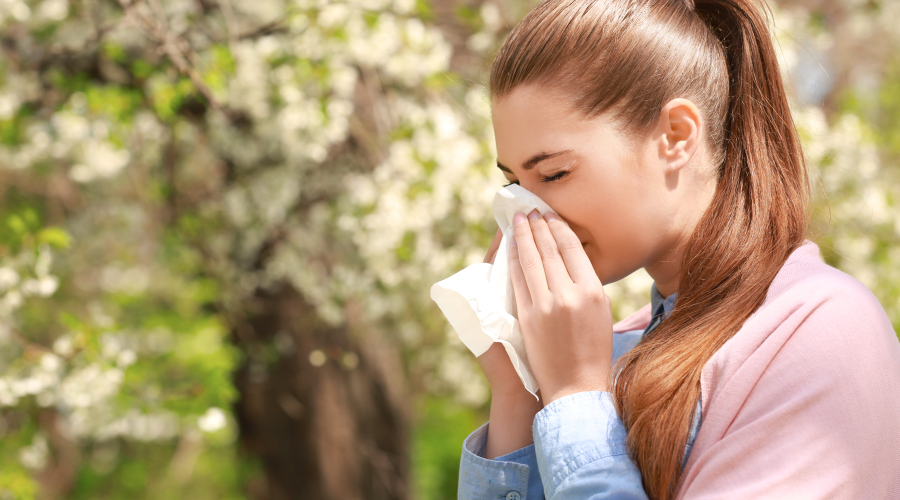

While spring is the season of wonderful weather, several joyous festivals and outdoor activities, one is more prone to allergies. A simple cold might be an indication of underlying spring allergies. However, this must not stop you from having fun or canceling your plans. Allergies can affect your immune system in the long run. These allergies are especially common in spring. Knowing the types of spring allergies and spring allergy symptoms is extremely helpful.
Causes of Allergy in Spring
Listed below are the main causes that lead to allergic reactions in spring season:
1. Pollen Allergy
This is the most common allergy that affects several people. Pollen is a fine powder-like substance produced by trees, flowers, and grasses which can create an adverse response in your immune system, leading to hay fever or allergic rhinitis. Some different types of pollen allergies are:
Grass Pollen Allergy: Grass acts as a primary trigger for pollen allergies. You may be sitting or simply walking on grass when the pollen can attach itself to your clothes or sensitive areas. This can be difficult to treat at times.
Oak Pollen Allergy: This is milder compared to other types of allergies. However, it can stay for longer periods and is caused by the pollen produced from oak trees.
Birch Pollen Allergy: This is among the most common pollen allergies which are airborne. This tree produces around 5 million pollen grains in the spring season.
2. Mold Allergy
This is less common and not an obvious trigger for allergies. Molds and Mildew excrete seeds, known as spores, to reproduce. These spores are airborne or can spread along with dew or fog in highly humid places. These molds can be found on old logs or trees, grains, in damp places, or dead plants that did not survive the winter cold. These can also form in the household in places like kitchens or bathrooms.
3. Insect Stings and Bites
These can include mosquitoes and even some harmful insects like bed bugs. The stings lead to irritation in the bitten area, swelling, and sometimes may even cause life-threatening reactions. These insects are most prevalent in humid and hot places.
Common Spring Allergy Symptoms
There are different allergic symptoms that commonly occur during the spring season. If you are dealing with these symptoms listed below, you may have one of the spring allergies:
1. Pollen Allergy Symptoms
The most obvious spring allergy symptom is sneezing, nasal passage blockage, a runny nose, coughing, scratchy throat, itchy and watery eyes that sometimes may also turn red. Asthma symptoms are also common; itchy ears, headache and dry skin can all point towards a pollen allergy.
2. Mold Allergy
Symptoms are more or less the same as that of a pollen allergy. Some symptoms are excessive sneezing; a constant runny nose; itchy eyes, nose, and throat; coughing; and dry and scaly skin. Mold allergies can also cause temporary asthma with shortness of breath, wheezing, and tightness in the chest region.
3. Insect Bites
The initial symptom of an insect bite includes feeling a sharp sting. It can sometimes turn allergic causing the immune system to become active and initiate a cascade reaction to your body. Mosquito bites are small, immediately become round, red, and puffy which can cause itchiness and irritation in the affected area.
Fire ant bites can cause an aggressive red spot with a blister, which can last up to a week. It may cause swelling and sometimes even shortness of breath. Bed bugs can cause hives to form on and around the bitten areas. Other insects that can cause allergic reactions on biting include spiders, lice, and ticks.
Allergy Treatment
Some precautions and remedies for spring allergies are:
- To prevent pollen allergies, it is recommended to stay indoors and wear dust masks that do not allow the pollen to penetrate. You must also avoid gardening or ask someone else to tackle it. Always check the weather before leaving your house and wear protective clothing.
- If you show any of the above-mentioned symptoms, then consult your doctor or allergist. An allergist is a professional trained in allergies specifically. They will ask about your medical history and present problems and diagnose you with the skin prick system.
- You will also be provided with the required medicine which usually includes antihistamines, decongestants, and Claritin-D for pollen allergies. For mold allergies, one will be prescribed nasal corticosteroids, oral decongestants, or even nasal lavage. For insect bites, each type has its own special medicine.
- Sometimes, experts also recommend immunotherapy or allergy shots. This includes daily shots of allergens to build up immunity over time in your body.
- You can also invest in air purifiers for your home, sanitize your clothes daily and take showers often to reduce the chances of allergies.
Conclusion
The spring allergy symptoms are similar but it is important to ensure that you are not leaving them unattended. Make sure you stay cautious and consult your doctor in case any of these symptoms seem to occur. Taking precautions is quite important in order to nip the spring allergies in the bud.




